The coronavirus that originated in Wuhan, China in late December spread to Iran in February. On February 19, the health ministry announced that two elderly people in Qom had died from the coronavirus. On February 23, Iran’s health minister Saeed Namaki blamed an Iranian merchant from Qom who had frequently traveled between Iran and China. On March 25, Alireza Raeesi, Iran's deputy health minister, claimed that COVID-19 was brought to Iran by Chinese nationals who studied and worked in Qom. Many of them studied at Al Mostafa University, a state-funded seminary with many international students. Raeesi added that Iranian students returning to Gilan from Wuhan may have created a second epicenter, which spread independently from the outbreak in Qom. President Hassan Rouhani later saconfirmed that the country’s COVID-19 outbreak likely started in Qom and Gilan provinces, where people who had traveled to Wuhan, China spread the virus to students and tourists.
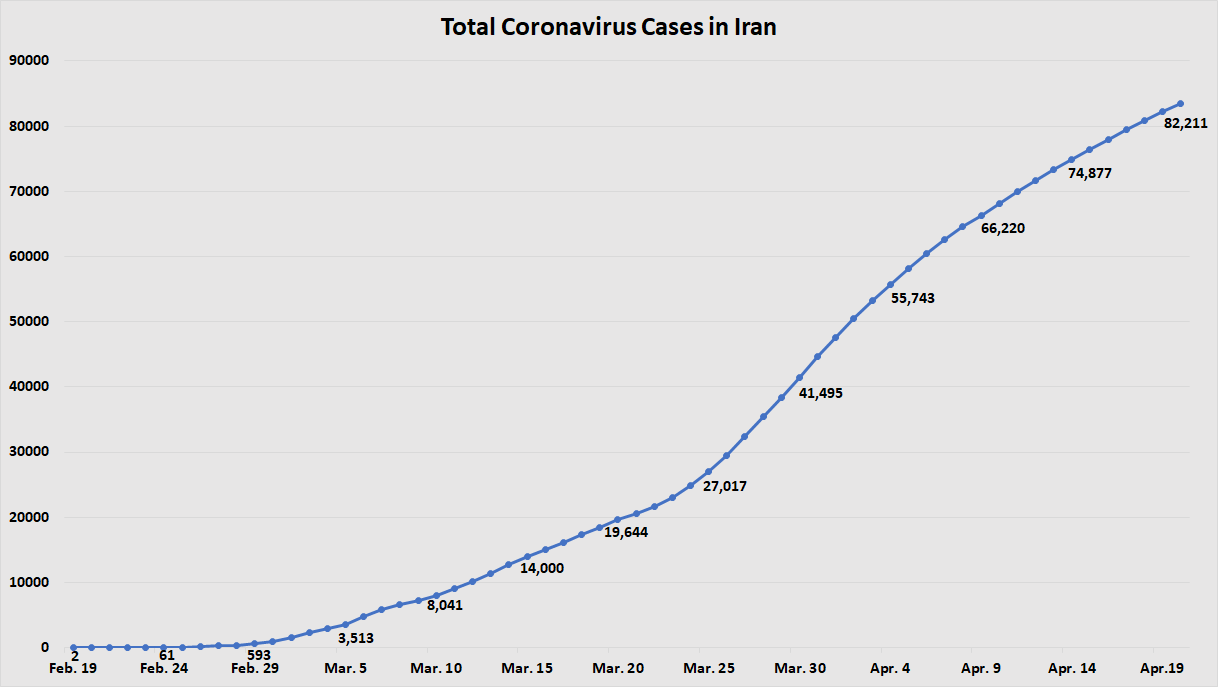
The virus spread quickly. By February 24, Iran’s Health Ministry reported 61 cases of coronavirus, resulting in 12 deaths. Cases were recorded in Arak, Babol, Isfahan, Qom, Rasht and Tehran. The ratio of cases to deaths was unusually high. Globally, the death rate was about two percent. By April 21, Iran reported 84,802 cases and 5,297 deaths—a death rate of 6.2 percent. The mortality rate had fluctuated daily. At one point, it was as high as 25 percent.
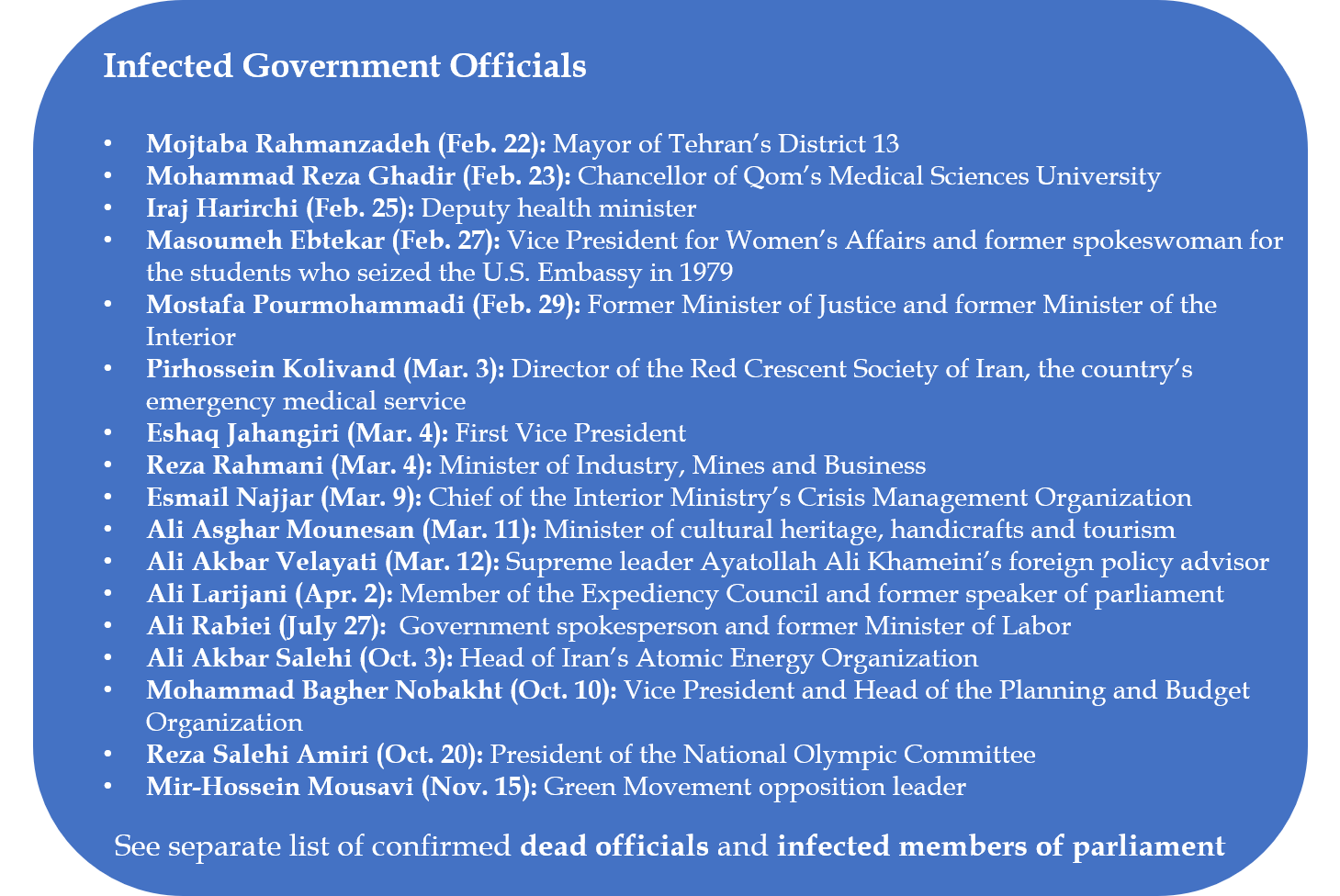
On March 17, Iranian state television journalist, Dr. Afruz Eslami, warned that "millions" could die if Iranians did not follow the government's travel restrictions and health guidance. Eslami cited a report from Tehran’s prestigious Sharif University of Technology. The study gave estimates based on three scenarios: if Iranians fully cooperate with government guidance, the country will see 120,000 infections and 12,000 deaths; if there is average cooperation, the country will see 300,000 cases and 110,000 deaths. Eslami said that poor cooperation with government guidelines would flood overwhelm hospitals and lead to 4 million cases and 3.5 million deaths.
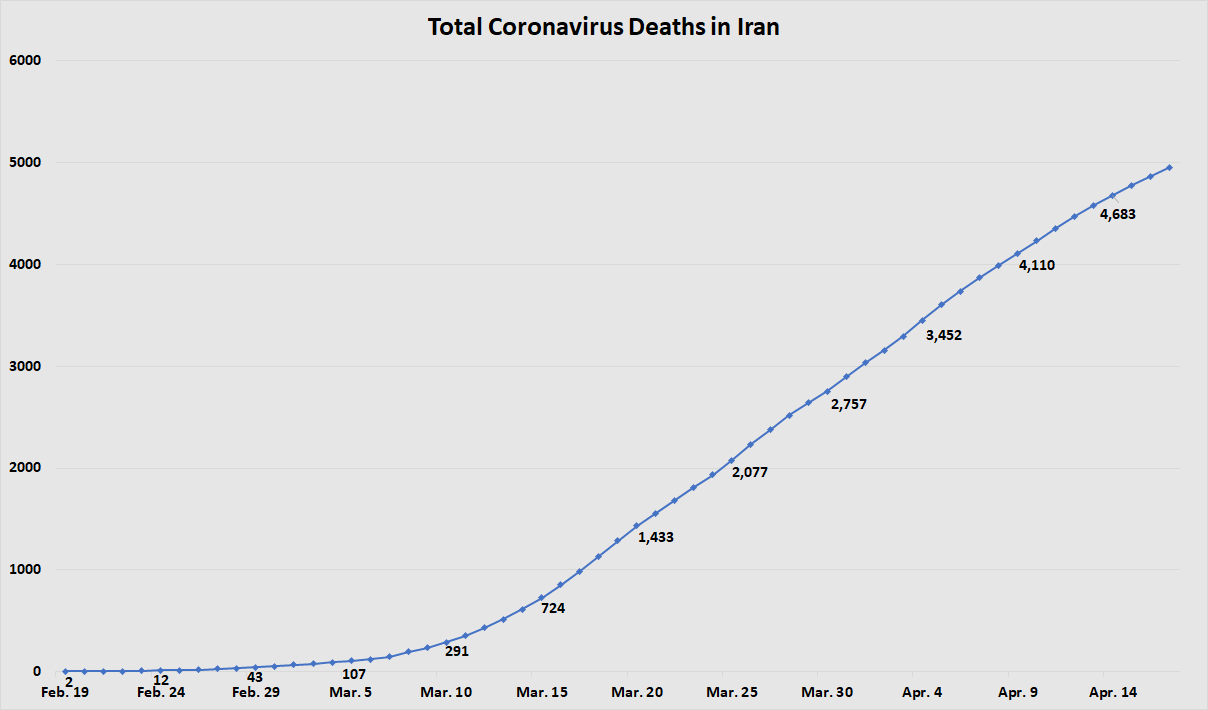
Medical experts and scientists studying infectious diseases predicted that Iran had many more cases than reported. A preliminary report, not yet peer reviewed, estimated on February 24 that Iran could have as many as 18,000 coronavirus cases. The Canadian research group used the number of international cases linked to Iran and air travel links between Iran and other countries to predict the likely number of cases. At least 23 countries – from the United States and Europe to the Middle East and New Zealand – reported coronavirus cases spread either by Iranian tourists or their own nationals who had recently returned from Iran.
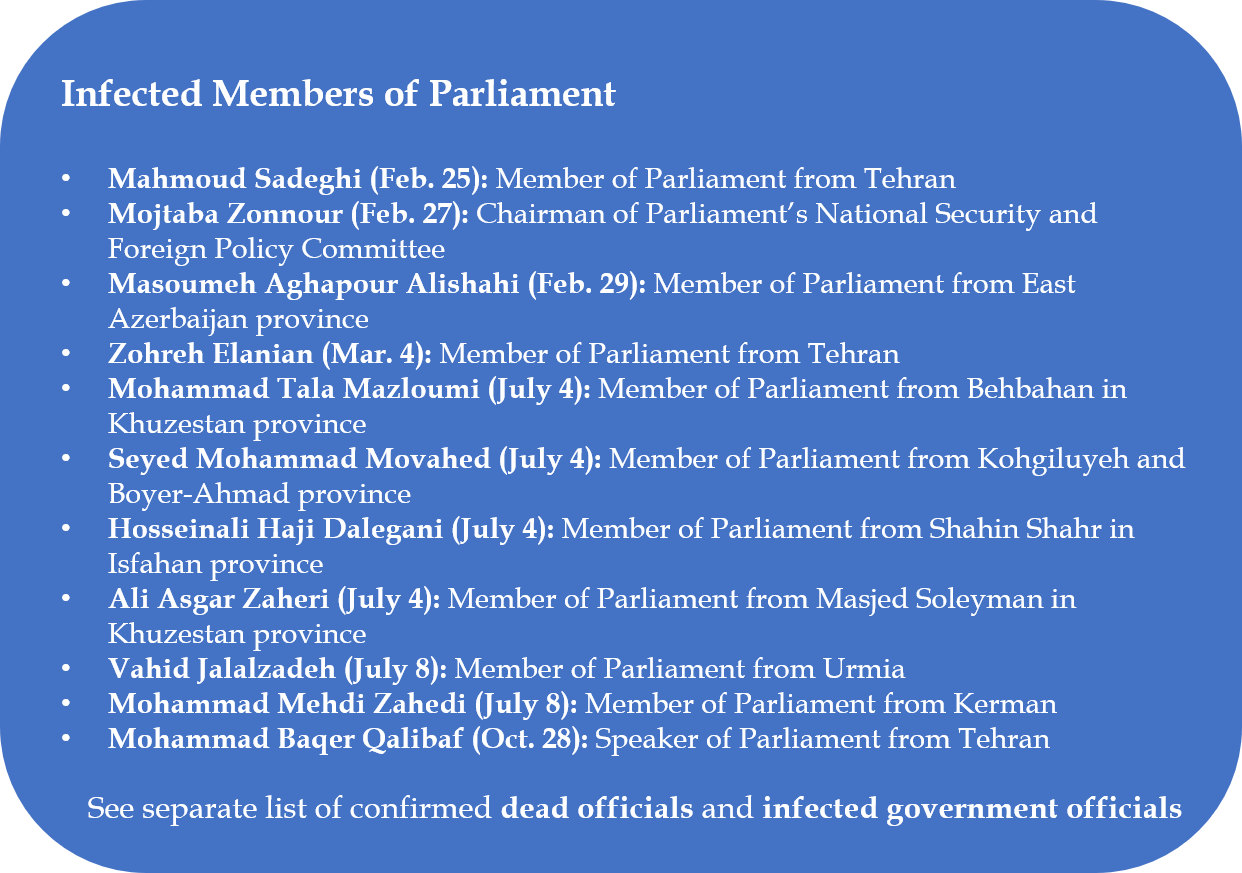
The outbreak led the Iranian government to close schools, universities and cultural centers in 14 provinces as a preventative measure. Soccer matches and movie screenings were suspended. In Tehran, authorities ordered snack shops and water fountains in subway stations to close. "We urge people to avoid shaking hands and kissing, to observe personal hygiene and preferably avoid crowded places," said Qasem Jan-Babaei, Iran's deputy health minister, during a press conference to announce the outbreak. The local government sent workers to disinfect buses and subway trains. Health Minister Namaki promised free treatment for coronavirus patients. He said that the country would dedicate 230 hospitals to fighting the virus. The following is a timeline for the first eight weeks of the coronavirus outbreak.
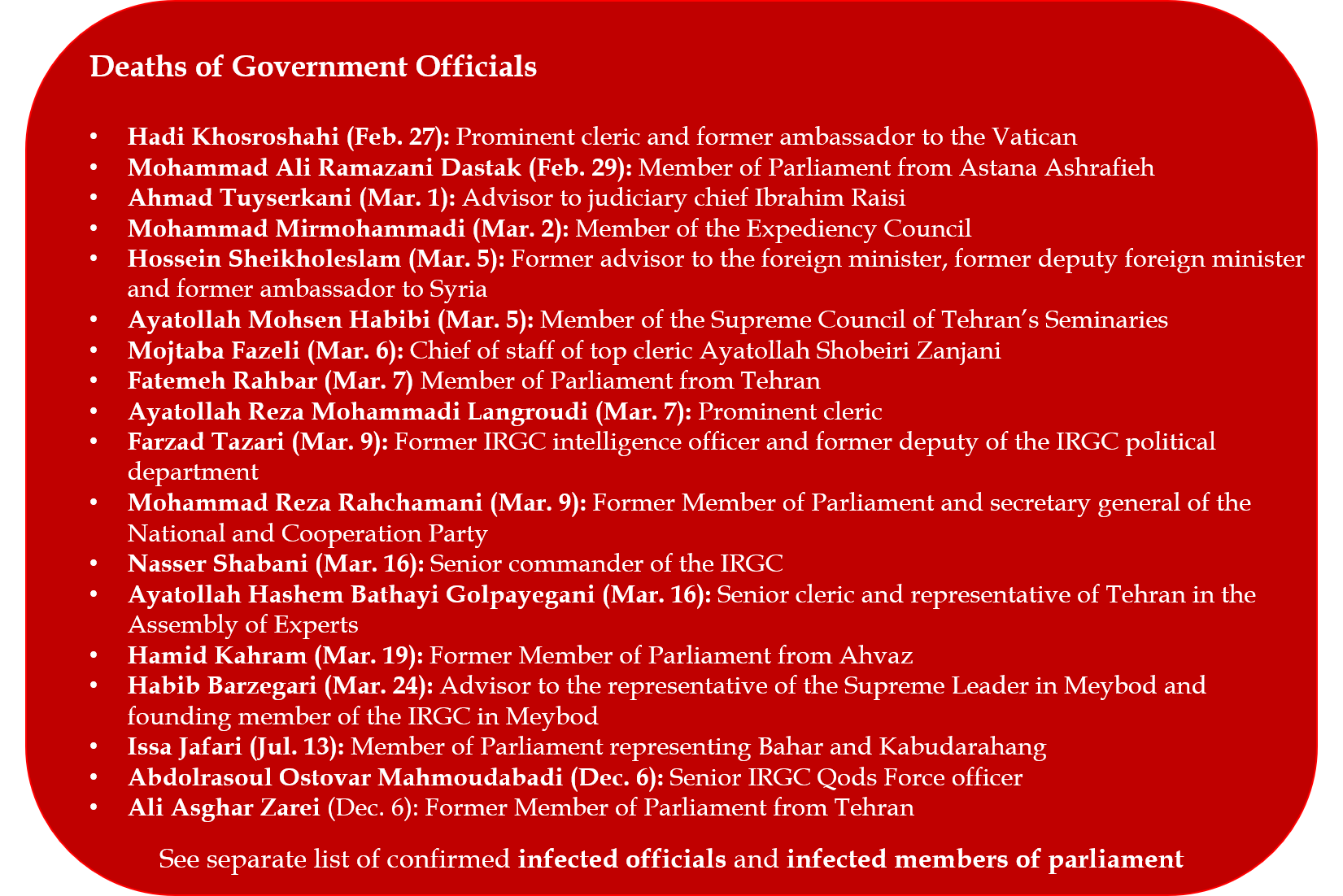
Week 1: February 16 – February 22
On February 19, Iran recorded its first case of the novel coronavirus.
Week 2: February 23 – February 29
On February 23, four of Iran's neighbors - Turkey, Pakistan, Afghanistan and Armenia - said that they would close their land borders. Afghanistan and Armenia suspended all air traffic, while Turkey halted arrival flights from Iran.
On February 24, President Rouhani assured the country that officials had “mobilized all of our resources” to contain the disease “in the shortest time with the minimum casualties.” Officials warned against overreacting to the outbreak, which they claimed was stabilized and under control. "We have managed to reduce the problem to the minimum," said Deputy Health Minister Iraj Harirchi.
Harirchi said that the government was against quarantines of Iranian cities, which he claimed could cause more harm than good. "With regard to quarantines – we are absolutely against them. Quarantines belong to pre-WWI – to the Plague, cholera, stuff like that," he said. "The Chinese themselves are not so pleased with the quarantine there. After all, quarantines have consequences. Let's suppose that you quarantine a certain city – what would the people of that city do? Look, we are carefully calculating all our decisions. We are analyzing and forecasting the effects of each decision we make. Let's assume that we shut down Qom for ten consecutive days. Everybody would go traveling, and this will cause the disease to spread all over the country."
But on the same day, Ahmad Amiriabadi Farahani, a lawmaker from Qom, accused the regime of covering up the true number of deaths and charged that the government had not done enough to stem infections. He reported that 50 people had died from the coronavirus in Qom. “So far, I have not seen any particular action to confront corona by the administration,” Farahani said.
On February 24, Harirchi refuted Farahani's claim during a press conference in which he appeared visibly sick, sweating profusely and using tissues to wipe his brow. "If it is confirmed that even half of this number is true, I will resign," Harirchi declared. A day later, the government reported that Harirchi had contracted the virus.
More than two dozen other officials also contracted the disease. Iranian health officials claimed that longstanding U.S. sanctions and the recent Financial Action Task Force’s decision to blacklist Iran had hindered the delivery of diagnostic test kits. “Multiple international companies are ready to supply Iran with corona (virus) test kits but we can’t send the money to them,” Ramin Fallah, vice president of the Iranian Union of Importers of Medical Equipment, said on February 24. Tedros Adhanom Ghebreyesus, director-general of the World Health Organization, called the sudden outbreak in Iran “very worrisome. We have to engage them even more.”
More than two dozen other officials also contracted the disease. Iranian health officials claimed that longstanding U.S. sanctions and the recent Financial Action Task Force’s decision to blacklist Iran had hindered the delivery of diagnostic test kits. “Multiple international companies are ready to supply Iran with corona (virus) test kits but we can’t send the money to them,” Ramin Fallah, vice president of the Iranian Union of Importers of Medical Equipment, said on February 24. Tedros Adhanom Ghebreyesus, director-general of the World Health Organization, called the sudden outbreak in Iran “very worrisome. We have to engage them even more.”

On February 25, U.S. Secretary of State Mike Pompeo accused Iran of covering up the extent of the outbreak. “The United States is deeply concerned by information indicating the Iranian regime may have suppressed vital details about the outbreak in that country,” Pompeo told reporters. “All nations, including Iran, should tell the truth about the coronavirus and cooperate with international aid organizations."
President Rouhani said that the virus was being used by Iran's adversaries to cause panic in the country. "In schools, high schools, universities and work places, everybody should pay attention to health recommendations, but we must all continue our work and activities, because it is one of the enemies' plots to spread fear in our country and close down the country," Rouhani said.
In a tweet, Foreign Minister Mohammad Javad Zarif emphasized that the coronavirus could infect anyone. He called for regional unity to fight the disease "in line with the Hormuz Peace Endeavor (HOPE)." President Rouhani had introduced HOPE, which he said would “promote peace, stability, progress and welfare for all the residents of the Strait of Hormuz region,” at the U.N. General Assembly in September.
Like other viruses - incl terrorism - #COVID19 knows no borders and doesn't distinguish between ethnicities or faiths.
— Javad Zarif (@JZarif) February 25, 2020
To combat it, neither should we.
In line with #HOPE, Iran calls for more regional cooperation incl long overdue Joint Center for Disease Control & Prevention.
Afghanistan reopened its land borders with Iran after being closed for two days.
On February 26, President Rouhani urged the public not to let the virus become a "weapon" of the United States. "We must not let the United States attach a new virus to the coronavirus by stopping our social activities through tremendous fear; this is a conspiracy we see today and you see in foreign propaganda," he said.
Week 3: March 1 – 7
On March 2, France, Germany and Britain provided the Iranian government with nearly $5.6 million to help fight the country's coronavirus outbreak. The countries also pledged to deliver medical equipment through the World Health Organization and other U.N. agencies. "France, Germany and the United Kingdom express their full solidarity with all impacted by COVID-19 in Iran," the countries said in a joint statement. "We are offering Iran a comprehensive package of both material and financial support to combat the rapid spread of the disease."
On March 4, President Rouhani said that the coronavirus had spread to nearly every province. He criticized U.S. offers of provide humanitarian aid. “They [the United States] have appeared with a mask of sympathy that ‘we also want to help the people of Iran," he said. “If you are really telling the truth, then lift sanctions from medicine.” To document the number of coronavirus deaths, an Iranian secretly took video of bodies at a cemetery morgue. IranWire reported that he was subsequently arrested for recording without a permit.
On March 5, Health Ministry Spokesman Kianush Jahanpur tweeted a map, which showed the spread of coronavirus in the Iran based on the movements of patients. Qom was the epicenter of Iran's outbreak.
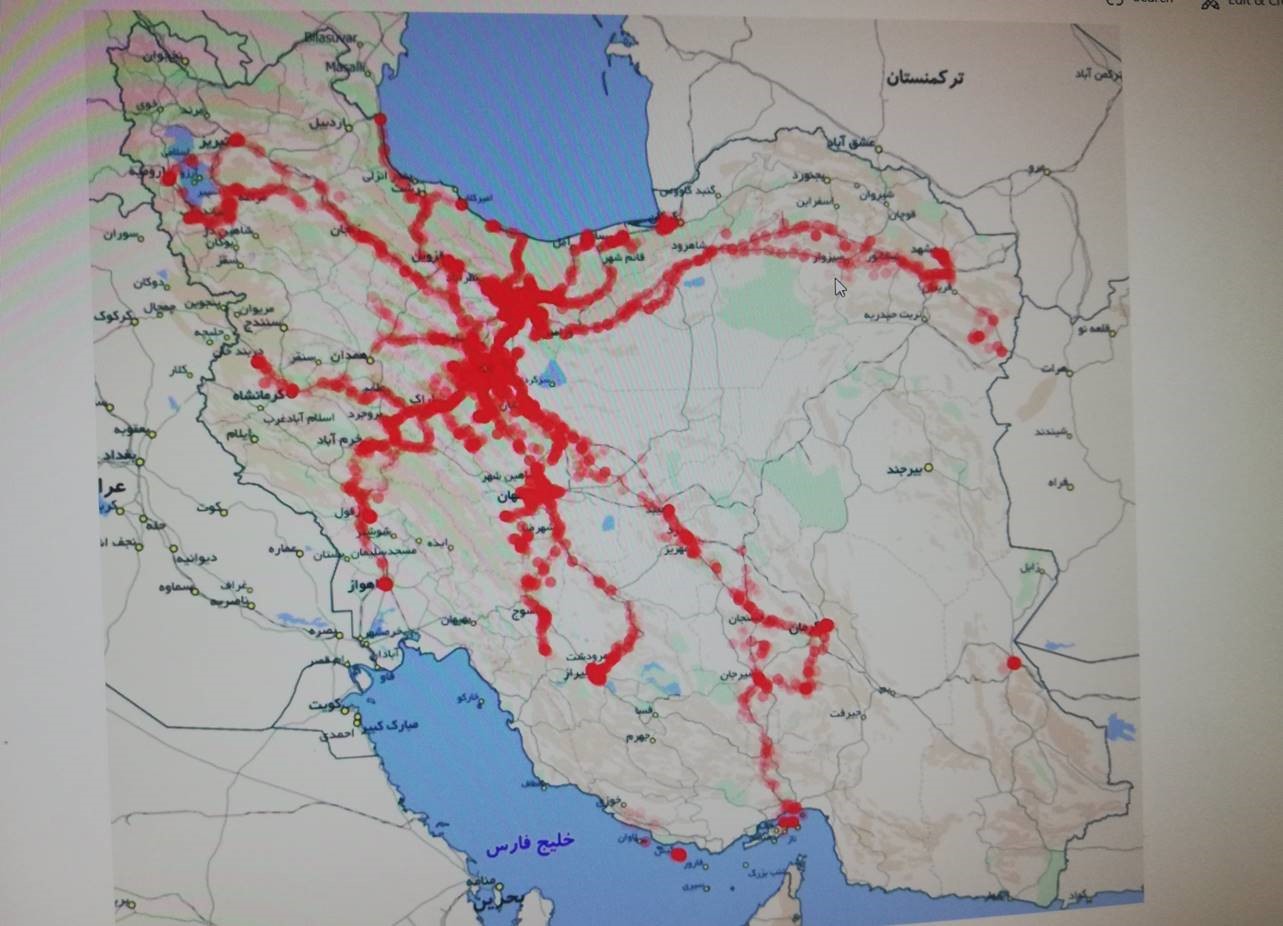
Week 4: March 8 – 14
On March 8, four lawmakers called on the Supreme National Security Council to order a “mandatory quarantine of Tehran, Qom and other infected centers.” They also urged wealthy religious foundations to distribute medical supplies.
Iraq closed its land borders with Iran until March 15.
On March 9, a lawmaker from Kashan, which is situated between two areas with high concentrations of cases – Qom and Isfahan – asked the Health Ministry to order offices in in Kashan closed. Javad Sadati Nejad noted that the city’s two hospitals were already short on medical supplies. He made a personal request for residents to avoid leaving their homes.
On March 9, the supreme leader’s office announced that Ayatollah Khamenei would not travel to the holy city of Mashhad to give his Nowruz (Persian New Year) address. The statement cited warnings from public health experts to limit travel. In his annual speech, Khamenei discussed pressing challenges to the country, accomplishments from the previous year and his vision for the next year.
On March 11, Iran reported that five members of the IRGC had died from coronavirus.
On March 12, Iran asked the International Monetary Fund (IMF) for a $5 billion emergency loan to help fight the country's coronavirus outbreak. The IMF “has stated that countries affected by #COVID19 (coronavirus) will be supported via Rapid Financial Instrument. Our Central Bank requested access to this facility immediately,” Foreign Minister Zarif said in a tweet. Iranian Central Bank chief Abdolnaser Hemmati wrote IMF managing director Kristalina Georgieva to request financial aid.
In a separate letter to U.N. Secretary General Antonio Guterres, Foreign Minister Zarif urged the United Nations to demand that the United States lift sanctions on Iran. He said that the U.S. “maximum pressure” campaign was hampering Iran’s ability to cope with the COVID-19 coronavirus. “Although our medical facilities, doctors, nurses and other health practitioners are among the very finest in the world, we are stymied in our efforts to identify and treat our patients; in combatting the spread of the virus; and, ultimately, in defeating it, by the campaign of economic terrorism perpetrated by the Government of the United States,” Zarif wrote.
Week 5: March 15 – March 21
On March 15, the U.S. State Department Persian-language account tweeted a link to an anonymous survey via Telegram, an encrypted social media app, to encourage Iranians to provide information about the country's coronavirus outbreak. Within three days, the account received some 7,000 responses to the 37-question survey. An unnamed State Department official said that the tips were mainly about "particular facilities that people have seen coronavirus victims, particular regions, particular misstatements by the officials." The State Department intended to use the data to determine if Iran was under-reporting cases. "The picture painted is one of intimidation and mass falsifications of statistics," the State Department official said. "We are getting the unfiltered facts."
Iraq indefinitely extended the closure of its land border with Iran.
On March 17, President Rouhani unveiled a stamp commemorating the medical professionals fighting Iran's coronavirus outbreak. The stamp was inscribed with the words "National Heroes."
Iran’s #coronavirus #stamp salutes #medical workers. #Iran has unveiled a postage stamp honoring medical professionals as front-line fighters of the #COVID19 outbreak in the country https://t.co/wC57pPSNnA #HealthForAll @WHO #WHO @iranpostCO @M_Sarkheil @Mm_Bahrami #philately pic.twitter.com/T5MzeHnjn1
— UniversalPostalUnion (@UPU_UN) March 19, 2020
On March 18, Foreign Minister Zarif slammed U.S. sanctions, which he called "economic terrorism," in his annual Nowruz speech. He accused the U.S. government of inhibiting Iran's ability to contain the coronavirus outbreak. “When a nation’s right to access to medicine, food and other humanitarian items is violated, it will be placed on an unequal and more vulnerable position in comparison with the other countries," he said. "The U.S. is trying to ultimately turn our country into an isolated island in an ocean of threats and miseries through the constant increase in the layers and depth of the sanctions."
On March 19, five former health ministers urged the regime to take "fundamental steps" to stem the spread of coronavirus in Iran. In a letter to President Rouhani, the former officials, who are also medical doctors, called on the government to take immediate measures, including "limiting movement of people, holiday trips, shutting non-essential businesses and big shopping centers." The doctors said that all non-essential activities should be halted for at least two weeks. "The trend of the disease and its consequences continue to show an upward trajectory and it has not declined in any part of the country," they warned.
On March 20, IranWire published evidence of Iran’s delay in responding to early signs of the coronavirus. The report cited guidelines issued on February 19 by Iran’s Civil Defense Organization, which revealed that the government ordered a three-day delay in implementing measures to stem the country's coronavirus outbreak. Subsequent reporting claimed that the government wanted to ensure a large turnout in parliamentary elections on February 21. Separately, Gholamreza Jalali, commander of the Civil Defense Organization, sent a letter, dated January 31, to the armed forces’ chief of staff, the secretary of the Supreme National Security Council and the interior minister in which he acknowledged a COVID-19 outbreak in Qom. The government did not report cases to the public until February 19.
Week 6: March 22 – March 28
On March 22, Supreme Leader Ayatollah Khamenei called U.S. leaders "charlatans and liars" and rejected the U.S. offer to provide humanitarian aid to Iran. “Several times Americans have offered to help us to fight the pandemic. That is strange because you face shortages in America. Also you are accused of creating this virus,” Khamenei said. “I do not know whether it is true. But when there is such an allegation, can a wise man trust you and accept your help offer? ... You could be giving medicines to Iran that spread the virus or cause it to remain permanently.”
President Rouhani said that Iran would not accept U.S. humanitarian aid and called on the United States to lift sanctions to help fight the virus. “American leaders are lying ... If they want to help Iran, all they need to do is to lift sanctions .... Then we can deal with the coronavirus outbreak,” Rouhani said.
Hamidreza Goudarzi, the deputy governor of Tehran Province, ordered all businesses except for gas stations, pharmacies, supermarkets and bakeries to close indefinitely.
On March 23, the U.N. High Commission for Refugees delivered 4.4 tons of medical supplies to Iran. The shipment included masks, gloves and essential medicines. The U.N. agency said that additional humanitarian aid deliveries were scheduled "in the coming weeks."
On March 24, President Rouhani announced that Iran would extend furloughs, from April 3 to April 19, that had been granted to 85,000 prisoners because of the pandemic. Tehran rejected humanitarian aid, including a 50-bed inflatable hospital and a 9-person emergency team, from Medecins Sans Frontieres (MSF) or Doctors Without Borders. “The Iranian Armed Forces' medical capabilities are entirely at its service, Iran did not need hospitals established by foreigners. The MSF presence in Iran is irrelevant,” said Ministry of Health advisor Alireza Vahhabzadeh. MSF said that the organization was "deeply surprised" to hear that the aid had been rejected. "The need for this intervention, and the authorizations needed to start it, were discussed and agreed with relevant Iranian authorities during the past weeks. Our teams were ready to start medical activities at the end of this week," said Michel Olivier Lacharité, manager of the MSF Emergency programs in Paris.
On March 25, President Rouhani said that Iran planned to implement a travel ban for the remainder of the two-week Nowruz holiday. "This plan is strict and it will create difficulties and restrictions for travel and prompt people who have already traveled to return home faster," he said. Rouhani added that all parks would be closed and Sizdah Bedar, an annual nature festival on April 1, "will not be like previous years."
Government spokesman Ali Rabiei warned that Iran could face a second wave of coronavirus cases if Iranians did not follow government orders. "Unfortunately some Iranians ignored advice from health ministry officials and travelled during the (Iranian) New Year holidays ... This could cause a second wave of the coronavirus," Rabiei said.
Iran announced that it would accept humanitarian aid from Medecins Sans Frontieres, a day after rejecting help from the international medical charity. "We thank Doctors Without Borders for their help. Their donated equipment will be used by the Ministry of Health in the areas where it is required," government spokesman Ali Rabiei said.
On March 28, President Rouhani said that Iran would allocate 20 percent of its new annual budget, or $6.3 billion (at free market values) to combat the COVID-19 outbreak. The allocation would include grants and low-interest loans to offset the impact of the virus.
Week 7: March 29 – April 4
On March 29, Deputy Health Minister Harirchi said that Tehran could not rule out the possibility that COVID-19 was a biological weapon deployed by the United States. He said that the Ministry of Health was conducting "serious investigations" into the matter. “If they just remove the barriers, we can provide the resources we need with oil and non-oil exports," he said.
President Rouhani urged citizens to continue with "the new way of life" in Iran, which he said could last for an extended period of time. "We must prepare to live with the virus until a treatment is discovered. The new measures that have been imposed are for everyone’s benefit. Our main priority is the safety and the health of our people," Rouhani said. He also appealed for national unity to fight the outbreak. "Another point I would like to say is that now is not the time for gathering teams and waging a political war; it is not about political war, nor party, nor ethnicity, nor national; but it is a public global issue," he said.
Foreign Minister Zarif accused the United States of waging an "economic war" on Iran. In a tweet, he said that sanctions amounted to war crimes. On March 30, State Department Spokesperson Morgan Ortagus said that Iran's regime, not sanctions, were the problem. In a tweet, she claimed that the supreme leader had access to a "tax-free hedge fund" worth billions of dollars. The U.S. government had previously accused Khamenei of profiting from an "off-the-books" hedge fund, allegedly valued at $95 billion, called the Setad.
Stop lying.
— Morgan Ortagus (@statedeptspox) March 30, 2020
Stop stealing.
If the Iranian regime needs funds to deal with the #coronavirus, it can access billions in @khamenei_ir's tax-free hedge fund.
It's not the sanctions. It's the regime. pic.twitter.com/WZ1gipkV3A
On April 1, President Rouhani said that Iran was successfully containing the outbreak. “Fortunately, the statistics I read last night from all the provinces shows a downward trend in all provinces,” he said at a cabinet meeting. Rouhani claimed that Iran’s increasingly strict travel restrictions and social distancing would curb infections without having to enforce the kind of lockdown used in Wuhan, China. His optimistic tone starkly contrasted with media reports that Iran’s healthcare system was severely overstretched.
On April 4, Deputy Health Minister Harirchi warned that Tehran could see a surge in coronavirus cases if citizens did not follow government guidelines. "We are still concerned about the virus, for example with the level of traffic in Tehran today and queues of cars stuck on freeways, because these people can take the virus to their homes or workplaces," he said.
Related Data and Analysis:
- Iran’s Response to Coronavirus
- Iran Mobilizes Military to Fight Coronavirus
- Coronavirus Spreads in Iran’s Prisons
- Coronavirus, a New Jolt to Iran's Economy?
- Iranian Officials Respond to Coronavirus
- How Iran's Public is Responding to Coronavirus
- Iranian Media on Evolution of Coronavirus
- U.S. Offers Aid on Coronavirus Outbreak
- Europe to Help Iran on Coronavirus
Alex Yacoubian, a program assistant at the U.S. Institute of Peace, compiled this report.
Photo Credits: Iranians wearing masks in Mashhad via Fars News Agency (CC BY 4.0); Iranian men wearing masks in Mashhad by Sajjad Tolouei via Fars News Agency (CC BY 4.0) on homepage
